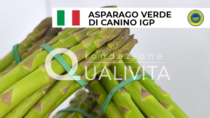Description
The Asparago Verde di Canino PGI refers to the fresh fleshy shoot, or turion, belonging to the species Asparagus officinalis L., obtained from the cultivars Atlas, Grande, UC157, Vegalim, Starlim, Italo, Atticus, and Verdus.
Production Area
The production area of Asparago Verde di Canino PGI is within the municipalities of Canino, Cellere, Montalto di Castro, Tarquinia, Tuscania, Tessennano, and Arlena di Castro, in the province of Viterbo, in the Lazio region.
Production Method
Asparago Verde di Canino PGI must be grown in open fields or in covered asparagus beds that are no more than 15 years old. The soil destined for this crop is prepared for planting by ploughing to a minimum depth of 50 cm. The seedlings, or "legs", must be planted in deep furrows ranging from 25 to 45 cm. The turions are harvested manually with the aid of a knife with a blade/palette on the end, which makes it possible to cut the turion below ground level. The maximum annual production is 12 tonnes per hectare. The harvest takes place from January to June and September to October. Immediately after harvesting, the asparagus are either washed and packaged to be sold directly, or subjected to the "blenciatura" process, which consists of blanching the product in hot water or steam at a temperature of between 70 and 105 °C for 3-5 minutes. This is followed by draining, a second selection, pre-cooling, and freezing. The product is then checked, weighed and packaged.
Appearance and Flavour
Asparago Verde di Canino PGI has straight, solid (not hollow) turions that are free of splits and have a closed tip. The spear is bright green with a purple-tinted tip. The diameter ranges from 8 mm to 10 mm for the Second category, from 10.1 to 16 mm for the First category, and over 16 mm for the Extra category. The turions are firm, not limp. They have a mild to intense smell, with no anomalous notes, and a sweet flavour with a grassy aftertaste.
History
The commercial success of Asparago Verde di Canino PGI dates back to the early 1980s, when the cultivation of asparagus spread to the Viterbo area. In the Italian Touring Club’s 2005 guide Frutta e ortaggi in Italia (Fruit and Vegetables in Italy) and the book 1001 specialità della cucina italiana da provare almeno una volta nella vita (1001 specialities of Italian cuisine to try at least once in your lifetime) by Amparo Machado and Chiara Prete (2015), this asparagus is described as "mangiatutto", because due to its non-fibrous texture the entire spear is edible.
Gastronomy
Fresh Asparago Verde di Canino PGI can be eaten immediately or kept at a temperature of 4°C for up to 48 hours. This vegetable is rich in potassium, iron and magnesium, and can be eaten both raw and cooked, without any waste. It pairs perfectly with fresh cheeses, fish or eggs, and is used as an ingredient in Tagliatelle with Asparago Verde di Canino and the traditional frittata monumentale (omelette).
Marketing
The product is marketed as Asparago Verde di Canino PGI, either fresh or as a third range product. The fresh product also indicates the category: Extra, First or Second. They are sold whole, in bunches weighing between 0.25 and 1 kg, in trays ranging from 0.125 and 1 kg, in boxes ranging from 1 and 6 kg, in crates weighing between 1 and 12 kg, or loose, packed in specifically labelled boxes. The third range product is sold in controlled atmosphere bags weighing between 0.10 and 10 kg, or vacuum sealed bags weighing between 0.5 and 10 kg.
Distinctive Features
Asparago Verde di Canino PGI is distinctive because of the uniformity of the edible part, the low fibrous content, and the absence of waste, thanks to which it is called the "mangiatutto" asparagus. This characteristic is determined by the particular pedoclimatic conditions and cultivation techniques.








